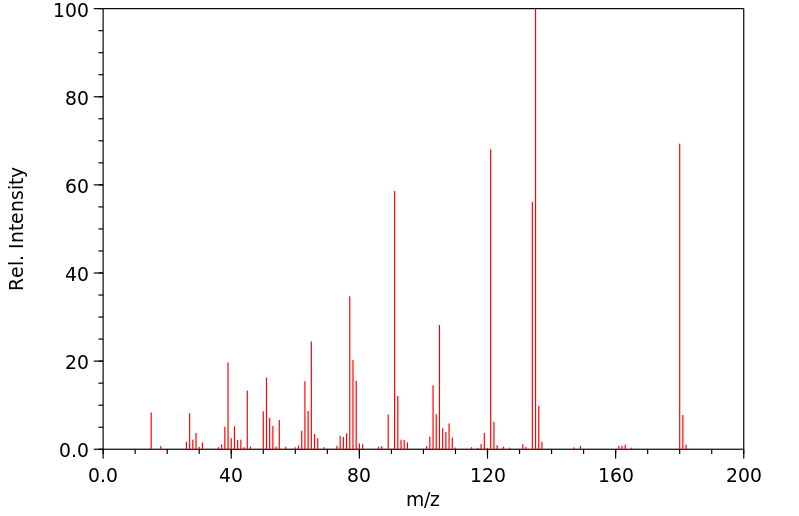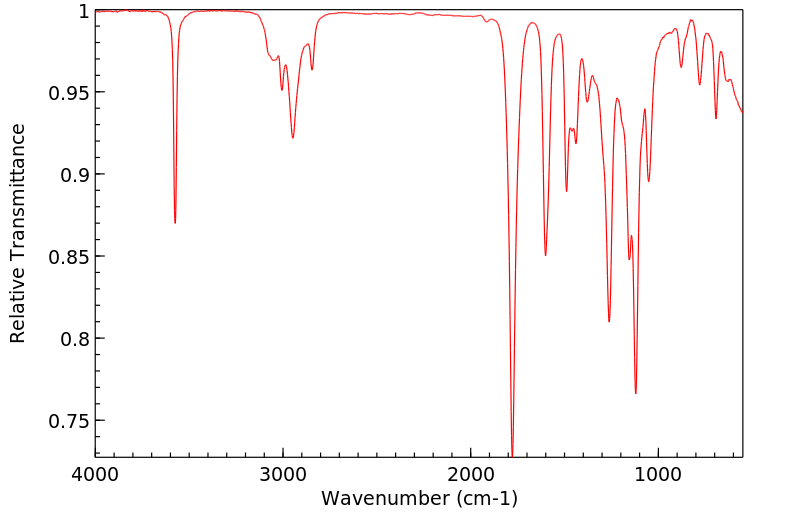3-(3-甲氧基苯基)丙酸 | 10516-71-9
物质功能分类
中文名称
3-(3-甲氧基苯基)丙酸
中文别名
间甲氧基-Β-苯丙酸;3-(3-甲氧基苯基丙酸)
英文名称
3-(3-Methoxy-phenyl)-propionic acid
英文别名
3-(3-methoxyphenyl)propanoic acid;3-methoxydihydrocinnamic acid;3-methoxybenzenepropanoic acid;β-(3-methoxyphenyl)propionic acid;3-(3-Methoxyphenyl)propionic acid
CAS
10516-71-9
化学式
C10H12O3
mdl
MFCD00014027
分子量
180.203
InChiKey
BJJQJLOZWBZEGA-UHFFFAOYSA-N
BEILSTEIN
——
EINECS
——
-
物化性质
-
计算性质
-
ADMET
-
安全信息
-
SDS
-
制备方法与用途
-
上下游信息
-
文献信息
-
表征谱图
-
同类化合物
-
相关功能分类
-
相关结构分类
物化性质
-
熔点:43-45 °C (lit.)
-
沸点:318.1±17.0 °C(Predicted)
-
密度:1.144±0.06 g/cm3(Predicted)
-
溶解度:溶于二甲基亚砜
-
物理描述:Solid
-
稳定性/保质期:
遵照规格使用和储存则不会分解。
计算性质
-
辛醇/水分配系数(LogP):2.1
-
重原子数:13
-
可旋转键数:4
-
环数:1.0
-
sp3杂化的碳原子比例:0.3
-
拓扑面积:46.5
-
氢给体数:1
-
氢受体数:3
安全信息
-
危险等级:IRRITANT
-
安全说明:S26,S36/37/39
-
危险类别码:R36/37/38
-
WGK Germany:3
-
海关编码:2918990090
-
危险性防范说明:P261,P305+P351+P338
-
危险性描述:H302,H315,H319,H335
-
储存条件:密封于阴凉干燥处。
SDS
Material Safety Data Sheet
Section 1. Identification of the substance
Product Name: 3-(3-Methoxyphenyl)propionic acid
Synonyms:
Section 2. Hazards identification
Harmful by inhalation, in contact with skin, and if swallowed.
Section 3. Composition/information on ingredients.
Ingredient name: 3-(3-Methoxyphenyl)propionic acid
CAS number: 10516-71-9
Section 4. First aid measures
Skin contact: Immediately wash skin with copious amounts of water for at least 15 minutes while removing
contaminated clothing and shoes. If irritation persists, seek medical attention.
Eye contact: Immediately wash skin with copious amounts of water for at least 15 minutes. Assure adequate
flushing of the eyes by separating the eyelids with fingers. If irritation persists, seek medical
attention.
Inhalation: Remove to fresh air. In severe cases or if symptoms persist, seek medical attention.
Ingestion: Wash out mouth with copious amounts of water for at least 15 minutes. Seek medical attention.
Section 5. Fire fighting measures
In the event of a fire involving this material, alone or in combination with other materials, use dry
powder or carbon dioxide extinguishers. Protective clothing and self-contained breathing apparatus
should be worn.
Section 6. Accidental release measures
Personal precautions: Wear suitable personal protective equipment which performs satisfactorily and meets local/state/national
standards.
Respiratory precaution: Wear approved mask/respirator
Hand precaution: Wear suitable gloves/gauntlets
Skin protection: Wear suitable protective clothing
Eye protection: Wear suitable eye protection
Methods for cleaning up: Mix with sand or similar inert absorbent material, sweep up and keep in a tightly closed container
for disposal. See section 12.
Environmental precautions: Do not allow material to enter drains or water courses.
Section 7. Handling and storage
Handling: This product should be handled only by, or under the close supervision of, those properly qualified
in the handling and use of potentially hazardous chemicals, who should take into account the fire,
health and chemical hazard data given on this sheet.
Store in closed vessels.
Storage:
Section 8. Exposure Controls / Personal protection
Engineering Controls: Use only in a chemical fume hood.
Personal protective equipment: Wear laboratory clothing, chemical-resistant gloves and safety goggles.
General hydiene measures: Wash thoroughly after handling. Wash contaminated clothing before reuse.
Section 9. Physical and chemical properties
Appearance: Not specified
Boiling point: No data
No data
Melting point:
Flash point: No data
Density: No data
Molecular formula: C10H12O3
Molecular weight: 180.2
Section 10. Stability and reactivity
Conditions to avoid: Heat, flames and sparks.
Materials to avoid: Oxidizing agents.
Possible hazardous combustion products: Carbon monoxide.
Section 11. Toxicological information
No data.
Section 12. Ecological information
No data.
Section 13. Disposal consideration
Arrange disposal as special waste, by licensed disposal company, in consultation with local waste
disposal authority, in accordance with national and regional regulations.
Section 14. Transportation information
Non-harzardous for air and ground transportation.
Section 15. Regulatory information
No chemicals in this material are subject to the reporting requirements of SARA Title III, Section
302, or have known CAS numbers that exceed the threshold reporting levels established by SARA
Title III, Section 313.
SECTION 16 - ADDITIONAL INFORMATION
N/A
Section 1. Identification of the substance
Product Name: 3-(3-Methoxyphenyl)propionic acid
Synonyms:
Section 2. Hazards identification
Harmful by inhalation, in contact with skin, and if swallowed.
Section 3. Composition/information on ingredients.
Ingredient name: 3-(3-Methoxyphenyl)propionic acid
CAS number: 10516-71-9
Section 4. First aid measures
Skin contact: Immediately wash skin with copious amounts of water for at least 15 minutes while removing
contaminated clothing and shoes. If irritation persists, seek medical attention.
Eye contact: Immediately wash skin with copious amounts of water for at least 15 minutes. Assure adequate
flushing of the eyes by separating the eyelids with fingers. If irritation persists, seek medical
attention.
Inhalation: Remove to fresh air. In severe cases or if symptoms persist, seek medical attention.
Ingestion: Wash out mouth with copious amounts of water for at least 15 minutes. Seek medical attention.
Section 5. Fire fighting measures
In the event of a fire involving this material, alone or in combination with other materials, use dry
powder or carbon dioxide extinguishers. Protective clothing and self-contained breathing apparatus
should be worn.
Section 6. Accidental release measures
Personal precautions: Wear suitable personal protective equipment which performs satisfactorily and meets local/state/national
standards.
Respiratory precaution: Wear approved mask/respirator
Hand precaution: Wear suitable gloves/gauntlets
Skin protection: Wear suitable protective clothing
Eye protection: Wear suitable eye protection
Methods for cleaning up: Mix with sand or similar inert absorbent material, sweep up and keep in a tightly closed container
for disposal. See section 12.
Environmental precautions: Do not allow material to enter drains or water courses.
Section 7. Handling and storage
Handling: This product should be handled only by, or under the close supervision of, those properly qualified
in the handling and use of potentially hazardous chemicals, who should take into account the fire,
health and chemical hazard data given on this sheet.
Store in closed vessels.
Storage:
Section 8. Exposure Controls / Personal protection
Engineering Controls: Use only in a chemical fume hood.
Personal protective equipment: Wear laboratory clothing, chemical-resistant gloves and safety goggles.
General hydiene measures: Wash thoroughly after handling. Wash contaminated clothing before reuse.
Section 9. Physical and chemical properties
Appearance: Not specified
Boiling point: No data
No data
Melting point:
Flash point: No data
Density: No data
Molecular formula: C10H12O3
Molecular weight: 180.2
Section 10. Stability and reactivity
Conditions to avoid: Heat, flames and sparks.
Materials to avoid: Oxidizing agents.
Possible hazardous combustion products: Carbon monoxide.
Section 11. Toxicological information
No data.
Section 12. Ecological information
No data.
Section 13. Disposal consideration
Arrange disposal as special waste, by licensed disposal company, in consultation with local waste
disposal authority, in accordance with national and regional regulations.
Section 14. Transportation information
Non-harzardous for air and ground transportation.
Section 15. Regulatory information
No chemicals in this material are subject to the reporting requirements of SARA Title III, Section
302, or have known CAS numbers that exceed the threshold reporting levels established by SARA
Title III, Section 313.
SECTION 16 - ADDITIONAL INFORMATION
N/A
制备方法与用途
生物活性
3-(3-甲氧基苯基)丙酸是一种天然存在的人类代谢物,它是一种有机酸,主要通过尿液排泄。
靶点Human Endogenous Metabolite(人类内源性代谢物)
化学性质:白色结晶,熔点50-51℃。
上下游信息
-
上游原料
中文名称 英文名称 CAS号 化学式 分子量 3-(3-甲氧基苯基)丙酸甲酯 methyl 3-(3-methoxyphenyl)propionate 50704-52-4 C11H14O3 194.23 3-(3-甲氧基苯基)丙酸乙酯 3-(3-methoxyphenyl)propanoic acid ethyl ester 7116-39-4 C12H16O3 208.257 3-(3-羟基苯基)丙酸 3-(3-hydroxyphenyl)-propanoic acid 621-54-5 C9H10O3 166.177 间甲氧基苯乙基溴 3-methoxyphenethyl bromide 2146-61-4 C9H11BrO 215.09 -
下游产品
中文名称 英文名称 CAS号 化学式 分子量 3-(3-甲氧基苯基)丙酸甲酯 methyl 3-(3-methoxyphenyl)propionate 50704-52-4 C11H14O3 194.23 3-(3-甲氧基苯基)丙醛 3-(m-methoxyphenyl)propanal 40138-66-7 C10H12O2 164.204 3-(3-甲氧基苯基)-1-丙醇 3-(3-methoxyphenyl)propan-1-ol 7252-82-6 C10H14O2 166.22 3-(3-甲氧基苯基)丙酸乙酯 3-(3-methoxyphenyl)propanoic acid ethyl ester 7116-39-4 C12H16O3 208.257 3-(3-羟基苯基)丙酸 3-(3-hydroxyphenyl)-propanoic acid 621-54-5 C9H10O3 166.177 —— 3-(3-methoxyphenyl)propanoyl chloride 40478-49-7 C10H11ClO2 198.649 —— methyl 3-(m-methoxyphenyl)-2-methylpropionate 62007-42-5 C12H16O3 208.257 3-(3-甲氧基苯基)丙酰胺 3-(3-methoxyphenyl)propionamide 57854-49-6 C10H13NO2 179.219 —— 3-(3-methoxyphenyl)propyl chloride 91817-84-4 C10H13ClO 184.666 3-(3-甲氧基苯基)丙腈 3-(3-methoxyphenyl)propanenitrile 1129-59-5 C10H11NO 161.203 3-(3-羟苯基)丙酸甲酯 methyl 3-(3-hydroxyphenyl)propionate 61389-68-2 C10H12O3 180.203 1-(3-溴丙基)-3-甲氧基苯 (m-methoxyphenyl)propyl bromide 6943-97-1 C10H13BrO 229.117 4-(3-甲氧基苯基)丁酸 4-(m-methoxyphenyl)butanoic acid 24743-11-1 C11H14O3 194.23 1-(3-丁烯-1-基)-3-甲氧基苯 4-(3-methoxyphenyl)-1-butene 1199-90-2 C11H14O 162.232 3-(3-甲氧基苯基)-1-丙胺 3-(3-Methoxyphenyl)propylamin 18655-52-2 C10H15NO 165.235 —— 3-(3'-methoxyphenyl)-1-butyronitrile 91152-85-1 C11H13NO 175.23 1-(4-戊炔基)-3-甲氧基苯 5-(m-Methoxyphenyl)pent-1-yne 1424-70-0 C12H14O 174.243 —— 3-(3-methoxyphenyl)propanoylhydrazine 425674-89-1 C10H14N2O2 194.233 —— 4-(3-methoxy-phenyl)-butyric acid amide 122875-15-4 C11H15NO2 193.246 —— 3-(3-methoxyphenyl)-N,N-dimethylpropan-1-amine 77318-04-8 C12H19NO 193.289 3-(3-羟丙基)-苯酚 3-(3-hydroxypropyl)phenol 1424-74-4 C9H12O2 152.193 5-(3-甲氧基苯基)戊酸甲酯 methyl 5-(3-methoxyphenyl)pentanoate 1373132-90-1 C13H18O3 222.284 —— 3-(3-methoxyphenyl)-N,N-dimethylpropanamide 1236981-85-3 C12H17NO2 207.272 (2-溴-5-甲氧基苯基)丙酸 3-(2-bromo-5-methoxyphenyl)propanoic acid 66192-02-7 C10H11BrO3 259.1 —— 3-(2-iodo-5-methoxyphenyl)propanoic acid 99254-50-9 C10H11IO3 306.1 —— 3-(3-methoxyphenyl)propyl sulfamate 723287-09-0 C10H15NO4S 245.299 —— 2-allyl-3-(3-methoxyphenyl)propionic acid 757950-83-7 C13H16O3 220.268 —— 3-(3-methoxyphenyl)propyl mesylate 310466-18-3 C11H16O4S 244.312 —— 6-(m-methoxyphenyl)hex-1-en-3-one 1444-59-3 C13H16O2 204.269 (S)-2-(3-甲氧基苄基)戊-4-烯-1-醇 (S)-2-(3-methoxybenzyl)pent-4-en-1-ol 1321545-43-0 C13H18O2 206.285 —— 7-(3-methoxyphenyl)heptane-1,4-diol 112778-17-3 C14H22O3 238.327 —— 4-Hydroxy-1,6-bis-(m-methoxyphenyl)-hexan-3-on 71505-81-2 C20H24O4 328.408 —— (E)-8-(3-methoxyphenyl)-5-methyloct-5-enal 1424371-49-2 C16H22O2 246.349 —— 1-Diethylamino-6-(m-methoxyphenyl)-hex-2-yne 1424-71-1 C17H25NO 259.392 —— 2-diazo-5-(3'-methoxyphenyl)pentan-3-one 378233-79-5 C12H14N2O2 218.255 —— N-(3'-methoxyphenethyl)-3-(3"-metoxyphenyl)propionamide 106488-76-0 C19H23NO3 313.397 5-(3-羟基苯基)戊酸 5-(3′-hydroxyphenyl)valeric acid 31129-95-0 C11H14O3 194.23 N-(3-甲氧基苯乙基)甲酰胺 N-[2-(3-methoxy-phenyl)-ethyl]-formamide 110339-54-3 C10H13NO2 179.219 —— 3-(3-bromopropyl)phenol 1971-83-1 C9H11BrO 215.09 —— (3-(3-methoxyphenyl)propanoyl)pyrrolidine 131656-86-5 C14H19NO2 233.31 —— 1,2-Bis[(3-methoxyphenyl)methyl]ethane-1,2-Dicarboxylic Acid 93578-36-0 C20H22O6 358.391 —— 1-isocyano-2-(3-methoxyphenyl)ethane 62334-10-5 C10H11NO2 177.203 —— (+)-(R)-4-(3-methoxybenzyl)dihydrofuran-2(3H)-one 77756-19-5 C12H14O3 206.241 —— 5-(3-methoxyphenethyl)dihydrofuran-2(3H)-one 1372559-34-6 C13H16O3 220.268 —— 2-[2-(3-methoxyphenyl)ethyl]cyclohexane-1,3-dione 6321-53-5 C15H18O3 246.306 6-甲氧基-3,4-二氢-1H-2-萘酮 6-methoxy-2-tetralone 2472-22-2 C11H12O2 176.215 5-甲氧基-1-茚酮 5-methoxy-1-indanone 5111-70-6 C10H10O2 162.188 —— (3R,4R)-3,4-bis[(3-methoxyphenyl)methyl]dihydro-2(3H)-furanone 80704-91-2 C20H22O4 326.392 3,4-二甲氧基外消旋肠内酯 trans-2,3-bis(3-methoxybenzyl)-4-butanolide 77756-17-3 C20H22O4 326.392 —— (S)-(-)-1,2,3,4-tetrahydro-7-methoxy-2-naphthalene carboxylic acid 136781-72-1 C12H14O3 206.241 5-甲氧基-2,3-二氢-1H-茚-1-醇 5-methoxy-1-indanol 3199-77-7 C10H12O2 164.204 - 1
- 2
- 3
- 4
- 5
- 6
反应信息
-
作为反应物:描述:3-(3-甲氧基苯基)丙酸 在 氯化亚砜 、 乙醇 、 氯仿 、 硫酸 、 sodium 、 N,N-二甲基苯胺 、 丙酮 、 甲苯 、 sodium iodide 作用下, 生成 3-(3'-methoxyphenyl)-1-butyronitrile参考文献:名称:308.合成与甾醇有关的物质的实验。第三部分 某些酮氢菲衍生物的新合成摘要:DOI:10.1039/jr9350001288
-
作为产物:描述:参考文献:名称:Tiemann; Ludwig, Chemische Berichte, 1882, vol. 15, p. 2055摘要:DOI:
文献信息
-
Pyridinylimidazoles as dual glycogen synthase kinase 3β/p38α mitogen-activated protein kinase inhibitors作者:Fabian Heider、Francesco Ansideri、Roberta Tesch、Tatu Pantsar、Urs Haun、Eva Döring、Mark Kudolo、Antti Poso、Wolfgang Albrecht、Stefan A. Laufer、Pierre KochDOI:10.1016/j.ejmech.2019.04.035日期:2019.8Alzheimer's disease. A set of 39 compounds was synthesized and evaluated in kinase activity assays for their ability to inhibit both target kinases. Among the synthesized compounds, potent dual-target-directed inhibitors showing IC50 values down to the low double-digit nanomolar range, were identified. One of the best balanced dual inhibitors presented in here is N-(4-(2-ethyl-4-(4-fluorophenyl)-1H-imidazol同时抑制参与同一复杂疾病进展的两个靶标的化合物可能会表现出累加甚至协同的治疗作用。在这里,我们介绍了2,4,5-三取代的咪唑类化合物,作为p38α丝裂原活化蛋白激酶和糖原合酶激酶3β(GSK3β)的双重抑制剂。两种酶都是神经退行性疾病(例如阿尔茨海默氏病)的潜在治疗靶标。合成了39种化合物,并在激酶活性测定中评估了它们抑制两种靶激酶的能力。在合成的化合物中,鉴定出了显示出低至两位数纳摩尔范围低的IC 50值的有效的双靶标抑制剂。这里介绍的最佳平衡双重抑制剂之一是N-(4-(2-乙基-4-(4-氟苯基)-1 H-咪唑-5-基)吡啶-2-基)环丙烷甲酰胺(20c)(p38α,IC 50 = 16 nM;GSK3β,IC 50 = 35 nM)具有优异的代谢稳定性和比密切相关的GSK3α明显的同工型选择性。我们的发现通过基于先前发布的X射线结构的计算机对接研究得到了合理化。
-
Vinylogous carbinolamine tumor inhibitors. 23. Synthesis and antileukemic activity of bis[[(carbamoyl)oxy]methyl]-substituted pyrrolo[2,1-a]isoquinolines, pyrrolo[1,2-a]quinolines, pyrrolo[2,1-a]isobenzazepines, and pyrrolo[1,2-a]benzazepines作者:Wayne K. Anderson、Arvela R. Heider、Natarajan Raju、Jeffery A. YuchtDOI:10.1021/jm00119a008日期:1988.11compound or with a mesoionic oxazolone intermediate. All of the bis(carbamates) were active in vivo against P388 lymphocytic leukemia with 5,6-dihydro-8-methoxy-1,2- bis(hydroxymethyl)pyrrolo[2,1-a]isoquinoline bis[N-(2-propyl)carbamate] (3c) showing the highest level of activity.
-
Generation of Phosphoranyl Radicals via Photoredox Catalysis Enables Voltage–Independent Activation of Strong C–O Bonds作者:Erin E. Stache、Alyssa B. Ertel、Tomislav Rovis、Abigail G. DoyleDOI:10.1021/acscatal.8b03592日期:2018.12.7oxygen-centered nucleophile. We show the desired reactivity in the reduction of benzylic alcohols to the corresponding benzyl radicals with terminal H atom trapping to afford the deoxygenated products. Using the same method, we demonstrate access to synthetically versatile acyl radicals, which enables the reduction of aromatic and aliphatic carboxylic acids to the corresponding aldehydes with exceptional chemoselectivity尽管醇和羧酸作为有机分子中的官能团盛行,并且有可能用作自由基前体,但C-O键仍然难以激活。我们报告了通过光氧化还原催化直接从这些普遍存在的官能团同时进入烷基和酰基自由基的合成策略。该方法利用了磷化氢自由基的独特反应性,该反应是由膦自由基阳离子和以氧为中心的亲核试剂之间的极性/ SET交叉产生的。我们显示了在末端醇被俘获以提供脱氧产物的情况下,将苄醇还原为相应的苄基所需要的反应性。使用相同的方法,我们演示了合成通用的酰基自由基的获得方法,可以将芳香族和脂肪族羧酸还原为相应的醛,并具有出色的化学选择性。该协议还通过分子内酰基自由基环化将羧酸转化为杂环和环状酮,从而一步一步形成C–O,C–N和C–C键。
-
A Biocompatible Alkene Hydrogenation Merges Organic Synthesis with Microbial Metabolism作者:Gopal Sirasani、Liuchuan Tong、Emily P. BalskusDOI:10.1002/anie.201403148日期:2014.7.21Organic chemists and metabolic engineers use orthogonal technologies to construct essential small molecules such as pharmaceuticals and commodity chemicals. While chemists have leveraged the unique capabilities of biological catalysts for small‐molecule production, metabolic engineers have not likewise integrated reactions from organic synthesis with the metabolism of living organisms. Reported herein
-
Cobalt‐Catalyzed Deoxygenative Hydroboration of Nitro Compounds and Applications to One‐Pot Synthesis of Aldimines and Amides作者:Kristina A. Gudun、Raikhan Zakarina、Medet Segizbayev、Davit Hayrapetyan、Ainur Slamova、Andrey Y. KhalimonDOI:10.1002/adsc.202101043日期:2022.2The commercially available and bench-stable Co(acac)2 ligated with bis[(2-diphenylphosphino)phenyl] ether (dpephos) was employed for selective room temperature hydroboration of nitro compounds with HBPin (TOF up to 4615 h−1), tolerating halide, hydroxy, amino, ether, ester, lactone, amide and heteroaromatic functionalities. These reactions offered a direct access to a variety of N-borylamines RN(H)BPin
表征谱图
-
氢谱1HNMR
-
质谱MS
-
碳谱13CNMR
-
红外IR
-
拉曼Raman
-
峰位数据
-
峰位匹配
-
表征信息
同类化合物
限制性核酸内切酶TAQⅠ(TTHHB8I)
阿明洛芬
阿拉洛芬
铁-N-(3-苯基戊二酰)去铁敏B
钙二[(2R)-2-羟基-3-苯丙酸酯]
酮洛芬相关物质C
酪泮酸钠
酪氨酸,3-羟基-b-亚甲基-
苯基丙酮酸缩氨基脲
苯基丁二酸
苯乙酸,a-甲基-4-(4,5,6,7-四氢-2-苯并噻唑基)-
苯丙酸钠盐
苯丙酸钙盐(2:1)
苯丙酸,加合N-环己基并环己胺(1:1)
苯丙酸,b-[[(苯基氨基)羰基]氨基]-
苯丙酸,b-[[(二乙胺基)硫代甲基]硫代]-
苯丙酸,a-[2-[甲基[2-(4-吗啉基)乙基]氨基]-2-羰基乙基]-,(R)-
苯丙酸,a-[(乙酰基硫代)甲基]-,(S)-
苯丙酸,4-羟基-b,2,6-三甲基-,(bR)-
苯丙酸,4-氯-a-(肟基)-
苯丙酸,3-硝基-b-(三氯甲锗烷基)-
苯丙酸,3-氯-a-羟基-
苯丙酸 羟基-4-甲氧基
苄氧羰基-DL-beta-苯丙氨酸
苄基马来酸
苄基丙二酸单酰肼
苄基丙二酸
苄基丁酸
艾司洛尔酸钠
艾司洛尔酸
胆影脒
羧基布洛芬
羟基布洛芬
美索洛芬
米格列奈
米格列奈
碘芬酸
碘番酸
碘泊酸钠
碘泊酸钙
硬脂酰胺丙基鲸蜡硬脂基二甲基铵甲苯磺酸盐
番石榴酸
甲酪氨酸
甲基多巴杂质A
甲基多巴EP杂质B
甲基多巴
甲基3-(4-苄氧基-2-甲基-苯基)丙酸酯
消旋甲酪氨酸
消旋布洛芬赖氨酸盐
消旋卡多曲二元酸杂质








